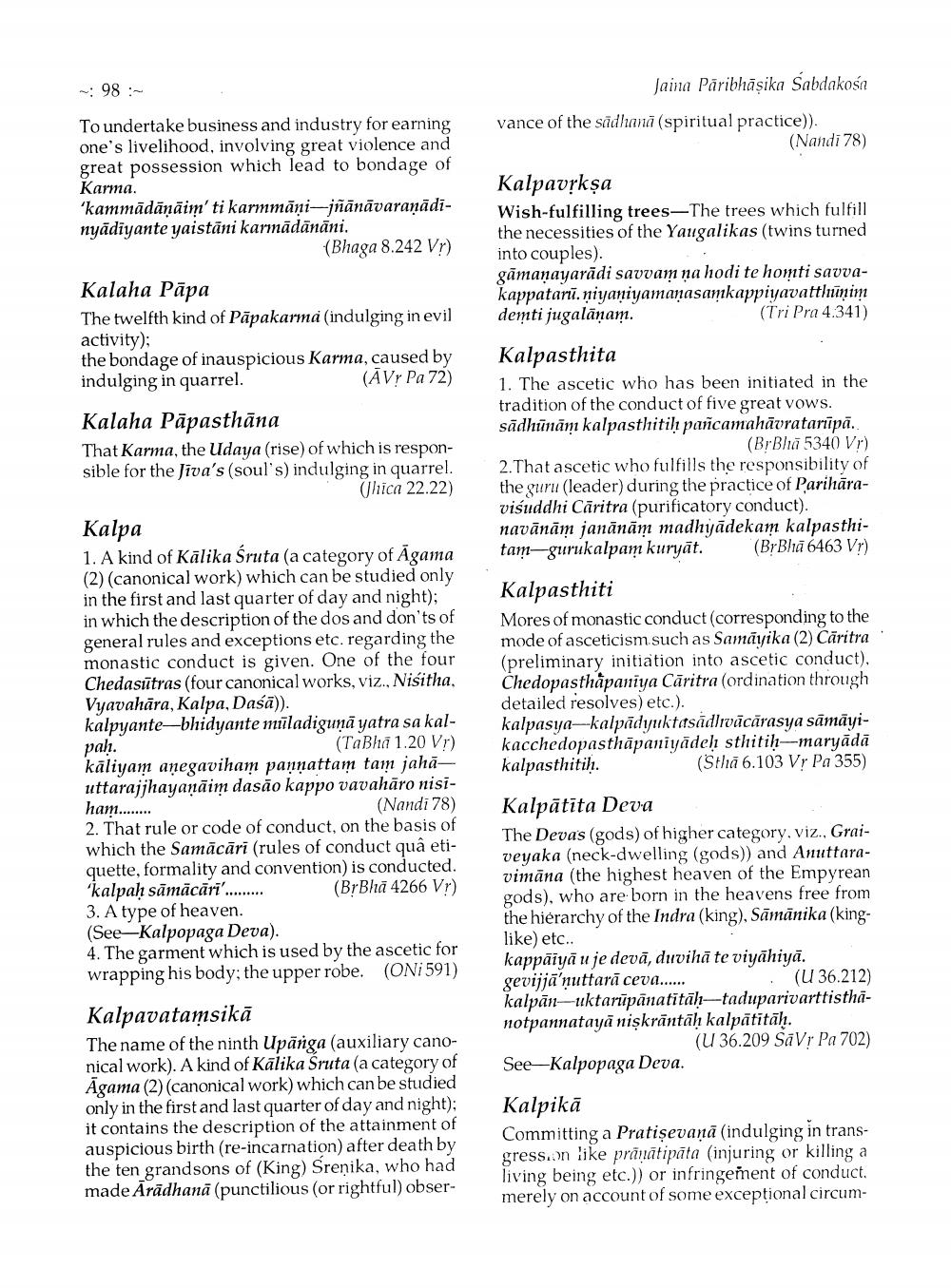________________
- 98:
Jaina Pāribhāşika Sabdakośn
vance of the sadhana (spiritual practice)).
(Nandi 78)
To undertake business and industry for earning one's livelihood, involving great violence and great possession which lead to bondage of Ката. 'kammādāņāim' ti karmmāņi-jñānāvaraņādinyādiyante yaistāni karmādānāni.
(Bhaga 8.242 Vr)
Kalpavrkça Wish-fulfilling trees—The trees which fulfill the necessities of the Yaugalikas (twins turned into couples). gamanayarādi savvam na hodi te homti savvakappatarū. niyaniyamanasamkappiyavattliūnim demti jugalāņam.
(Tri Pra 4.341)
Kalaha Pāpa The twelfth kind of Pāpakarma (indulging in evil activity); the bondage of inauspicious Karma, caused by indulging in quarrel.
(ĀVr Pa 72)
Kalaha Pāpasthāna That Karma, the Udaya (rise) of which is responsible for the Jiva's (soul's) indulging in quarrel.
Uhica 22.22)
Kalpasthita 1. The ascetic who has been initiated in the tradition of the conduct of five great vows. sādhūnām kalpasthitil pañcamahävratarūpā.
(BrBha 5340 Vr) 2.That ascetic who fulfills the responsibility of the guru (leader) during the practice of Parihāravisuddhi Căritra (purificatory conduct). navānām janānām madhijādekam kalpasthitam-gurukalpam kuryāt. (BrBlā 6463 Vr)
Kalpa 1. A kind of Kālika Sruta (a category of Agama (2) (canonical work) which can be studied only in the first and last quarter of day and night); in which the description of the dos and don'ts of general rules and exceptions etc. regarding the monastic conduct is given. One of the four Chedasūtras (four canonical works, viz., Nisitha. Vyavahāra, Kalpa, Daśā)). kalpyante—bhidyante miīladigunā yatra sa kalpah.
(Ta Bhi 1.20 Vr) kāliyam anegaviham pannattam tam jahāuttarajjhayaņāim dasāo kappo vavahāro nisiham........
(Nandi 78) 2. That rule or code of conduct, on the basis of which the Samācāri (rules of conduct quâ etiquette, formality and convention) is conducted. 'kalpah sāmācāri ......... (BrBhā 4266 Vr) 3. A type of heaven. (See-Kalpopaga Deva). 4. The garment which is used by the ascetic for wrapping his body; the upper robe. (ONi 591)
Kalpasthiti Mores of monastic conduct (corresponding to the mode of asceticism such as Samāyika (2) Cäritra (preliminary initiation into ascetic conduct). Chedopasthapaniya Cāritra (ordination through detailed resolves) etc.). kalpasya-kalpädyuktasādlivācārasya sāmāyikacchedopasthāpaniyādeh sthitin-maryādā kalpasthitih.
(Sthā 6.103 Vr Pa 355)
Kalpātita Deva The Devas (gods) of higher category, viz., Graiveyaka (neck-dwelling (gods) and Anuttaravimāna (the highest heaven of the Empyrean gods), who are born in the heavens free from the hierarchy of the Indra (king), Sāmānika (kinglike) etc.. kappāiyā u je devā, duvihā te viyāhiyā. gevijjā'nuttarā ceva...
(U 36.212) kalpan--uktarīpānatitāh-taduparivarttisthanotpannatayā niskrāntāḥ kalpātitäh.
(U 36.209 SãVr Pa 702) See-Kalpopaga Deva.
Kalpavatamsikā The name of the ninth Upānga (auxiliary canonical work). A kind of Kālika Sruta (a category of Agama (2) (canonical work) which can be studied only in the first and last quarter of day and night); it contains the description of the attainment of auspicious birth (re-incarnation) after death by the ten grandsons of (King) Srenika, who had made Ārādhanā (punctilious (or rightful) obser
Kalpikā Committing a Pratişevanā (indulging in transgress.on like prärātipāta (injuring or killing a living being etc.)) or infringement of conduct. merely on account of some exceptional circum




